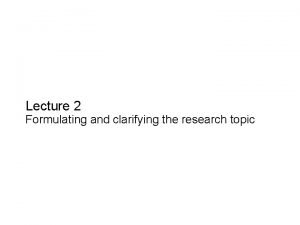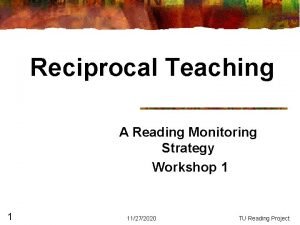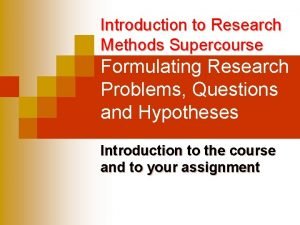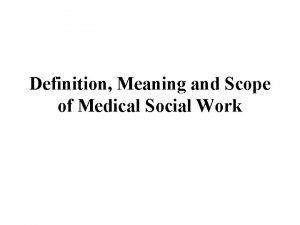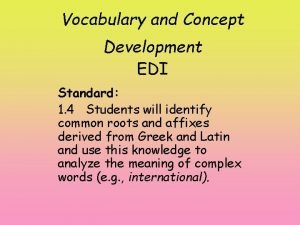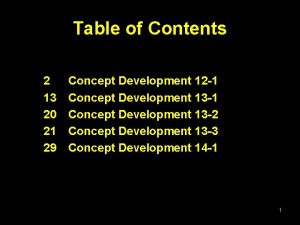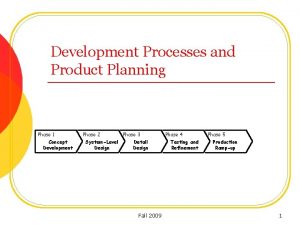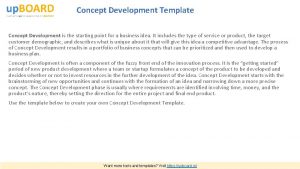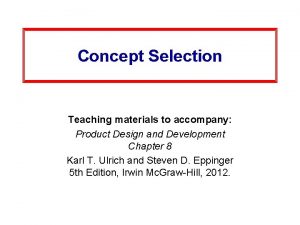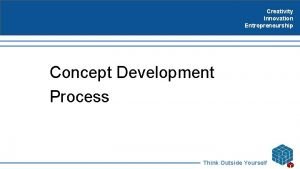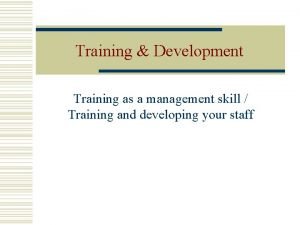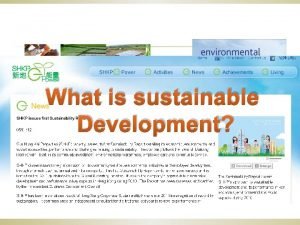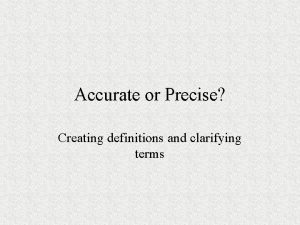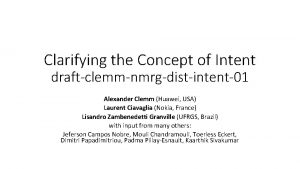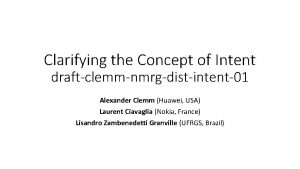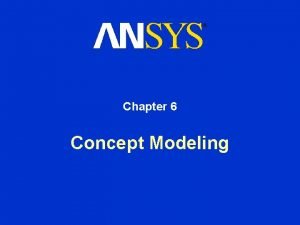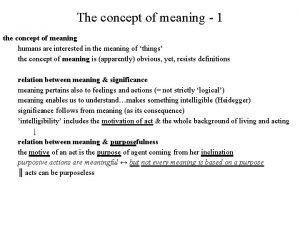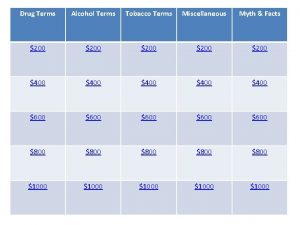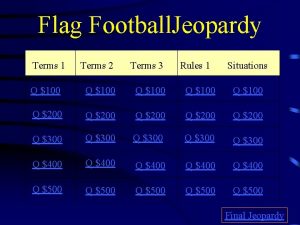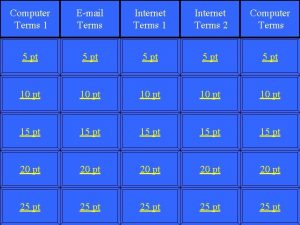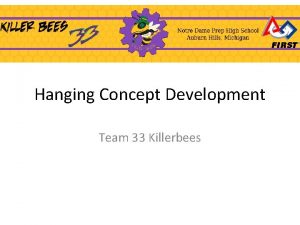Chapter 3 Concept Development Clarifying Meaning of Terms





































- Slides: 37

Chapter 3 Concept Development: Clarifying Meaning of Terms Copyright © 2015 Wolters Kluwer Health | Lippincott Williams & Wilkins

Concepts—Introduction • Ursprache—a language that is the recorded or hypothetical ancestor of another language or group of languages Copyright © 2015 Wolters Kluwer Health | Lippincott Williams & Wilkins

Concepts—Introduction—(cont. ) • Heiligenschein is the name for an optical effect, which creates a bright spot around the shadow of a viewer’s head when this viewer is looking at it. It is created when the surface on which the shadow falls has special optical characteristics. Dewy grass is known to exhibit these characteristics and create a heiligenschein. Nearly spherical dew droplets act as lenses to focus the light on the surface beneath them. Some of this light “backscatters” in the direction of the sunlight as it passes back through the dew droplet. This makes the antisolar point appear the brightest (Wikipedia). Copyright © 2015 Wolters Kluwer Health | Lippincott Williams & Wilkins

Concepts—Introduction—(cont. ) • Clinamen—the spontaneous microscopic swerving of atoms from a vertical path as they fall. According to Lucretius, there would be no contact between atoms without the clinamen, and so, “No collision would take place and no impact of atom upon atom would be created. Thus nature would never have created anything” (lines 220– 225). This was first described in Epicurian physics (Wikipedia). Copyright © 2015 Wolters Kluwer Health | Lippincott Williams & Wilkins

Concept—Definitions • Terms that refer to phenomena that occur in nature or thought • An abstract term derived from particular attributes about a phenomenon • Symbolic statement describing a phenomenon Copyright © 2015 Wolters Kluwer Health | Lippincott Williams & Wilkins

Question Tell whether the following statement is true or false: Concepts are words or phrases that refer to or describe a phenomenon. Copyright © 2015 Wolters Kluwer Health | Lippincott Williams & Wilkins

Answer True Rationale: Concepts are terms that refer to or describe phenomena that occur in nature or thought. Copyright © 2015 Wolters Kluwer Health | Lippincott Williams & Wilkins

Concept—Definition Commonalities • Term or word • Abstract or symbolic • Refers to a phenomenon Copyright © 2015 Wolters Kluwer Health | Lippincott Williams & Wilkins

Concept—Characteristics • Concrete (airplane, body temperature, pain) or abstract (hope, love, comfort) • Can be directly or indirectly seen, heard, felt, smelled, etc. Copyright © 2015 Wolters Kluwer Health | Lippincott Williams & Wilkins

Concept —Characteristics—(cont. ) • May be a: – Word – Two words – Phrase Copyright © 2015 Wolters Kluwer Health | Lippincott Williams & Wilkins

Concept—Characteristics—(cont. ) • When operationalized, concepts become variables tested in research. • Scholars within a discipline must define concepts clearly and accurately. • Concepts are used as bricks in theory building. Copyright © 2015 Wolters Kluwer Health | Lippincott Williams & Wilkins

Types of Concepts—Borrowed • Physiology—adaptation, homeostasis • Psychology—personality, cognition, id • Biology—cell, species, protoplasm • Sociology—culture, community Copyright © 2015 Wolters Kluwer Health | Lippincott Williams & Wilkins

Types of Concepts—Concrete • Directly observable empirical referents (can be seen, felt, or heard) • Limited by time and space and are observable in reality Copyright © 2015 Wolters Kluwer Health | Lippincott Williams & Wilkins

Types of Concepts—Abstract • Are not clearly observable directly or indirectly • Must be defined in terms of observable concepts • Independent of time and space Copyright © 2015 Wolters Kluwer Health | Lippincott Williams & Wilkins

Types of Concepts—Variable • Variable or continuous concepts allow classification on a continuum (e. g. , blood pressure, temperature, pain) • Examples in nursing include – Pain – Hope – Quality of life – Grief – Social support Copyright © 2015 Wolters Kluwer Health | Lippincott Williams & Wilkins

Question Which is NOT a variable concept? A. Desire B. Gender C. Health D. Knowledge E. Pain Copyright © 2015 Wolters Kluwer Health | Lippincott Williams & Wilkins

Answer B. Gender Rationale: Gender is a discrete concept. Copyright © 2015 Wolters Kluwer Health | Lippincott Williams & Wilkins

Types of Concepts—Discrete • Discrete or nonvariable concepts identify categories or classes of phenomena. • Discrete variables can be qualified as “yes” or “no” or categorized into groups. • Examples used in nursing include – Gender – Ethnicity – Marital status – Education level (e. g. , high school, some college, college grad) Copyright © 2015 Wolters Kluwer Health | Lippincott Williams & Wilkins

Concept Development • Concept analysis, concept development, and concept synthesis bring clarity to the definition of concepts used in a science. • Concept analysis/development is the process of inquiry that explores the meaning of concepts. • The purpose of concept development is to promote understanding. Copyright © 2015 Wolters Kluwer Health | Lippincott Williams & Wilkins

Concept Development—(cont. ) • Theory, research, and practice are linked. • When concepts have been identified, named, and developed, they can be tested in research studies. – Researchers construct concepts into models and theories. – Theories can be applied in practice. – Practice leads to questions for research. Copyright © 2015 Wolters Kluwer Health | Lippincott Williams & Wilkins

Strategies for Concept Development • There are several methods for constructing meaning for concepts. • Most of the methods used in nursing are derived from a process developed by a sociologist in the early 1960 s (Wilson). Copyright © 2015 Wolters Kluwer Health | Lippincott Williams & Wilkins

Strategies for Concept Development —Walker and Avant • First published in 1986; 5 th edition, 2011 • Oldest and most frequently used method in nursing Copyright © 2015 Wolters Kluwer Health | Lippincott Williams & Wilkins

Strategies for Concept Development —Walker and Avant—(cont. ) • Three processes – Concept analysis—used when concepts require basic definition and clarification for research or scholarship – Concept synthesis—used when concepts require observation or other forms of research for development – Concept derivation—used when there are few concepts available to explain a nursing problem; examination of non-nursing phenomena Copyright © 2015 Wolters Kluwer Health | Lippincott Williams & Wilkins

Question Which of Walker and Avant’s processes for concept development is most likely used to examine a non-nursing concept? A. Concept analysis B. Concept derivation C. Concept synthesis Copyright © 2015 Wolters Kluwer Health | Lippincott Williams & Wilkins

Answer B. Concept derivation Rationale: Walker and Avant would most likely use concept derivation to examine a non-nursing concept. Copyright © 2015 Wolters Kluwer Health | Lippincott Williams & Wilkins

Strategies for Concept Analysis— Walker and Avant – W&A process of concept analysis 1. Select a concept. 2. Determine the purpose of the analysis. 3. Identify uses of the concept. 4. Determine defining attributes. 5. Construct a model case. 6. Construct borderline, related, contrary, invented, and illegitimate cases. 7. Identify antecedents and consequences. 8. Define empirical referents. Copyright © 2015 Wolters Kluwer Health | Lippincott Williams & Wilkins

Concept Analysis—Walker and Avant— Examples Concept Author(s)/Date Journal Compassion fatigue Jenkins & Warrant, 2012 Critical Care Nursing Quarterly Confidence Perry, 2011 Nursing Forum Compliance Ingram, 2009 Shame Mc. Fall & Johnson, 2009 Journal of Testing & Theory Construction Tolerance Moore & Walker, 2011 Journal of Theory Construction & Testing Nursing Forum Copyright © 2015 Wolters Kluwer Health | Lippincott Williams & Wilkins

Strategies for Concept Development —Rodgers and Knafl • “Evolutionary method” first published in 1989; 2 nd edition published in 2000 • Concurrent task approach rather than sequential as with W&A Copyright © 2015 Wolters Kluwer Health | Lippincott Williams & Wilkins

Strategies for Concept Development— Rodgers • Rodgers’ process of concept analysis 1. Identify the concept and associated terms. 2. Select a setting or sample for data collection. 3. Collect data to identify the attributes of the concept and its contextual basis. 4. Analyze the data regarding concept characteristics. 5. Identify an exemplar of the concept. 6. Identify hypotheses and implications for further research. Copyright © 2015 Wolters Kluwer Health | Lippincott Williams & Wilkins

Strategies for Concept Development — Rodgers and Knafl—Examples Concept Author(s)/Date Journal Chronic fatigue Jorgenson, 2008 Journal of Advanced Nursing Community health Baisch, 2009 Journal of Advanced Nursing Death anxiety Lehto & Stein, 2009 Research and Theory for Nursing Practice Moral distress Russell, 2012 Journal of Neuroscience Nursing Self-awareness Eckroth-Bucher, 2010 Advances in Nursing Science Copyright © 2015 Wolters Kluwer Health | Lippincott Williams & Wilkins

Other Concept Development Strategies • Hybrid method—Schwartz-Barcott and Kim – Theoretical phase – Fieldwork phase – Analytical phase • Meleis – Concept exploration – Concept clarification – Concept analysis Copyright © 2015 Wolters Kluwer Health | Lippincott Williams & Wilkins

Other Concept Development Strategies— (cont. ) • Morse – Concept delineation – Concept comparison – Concept clarification • Penrod and Hupcey – Principle-based concept analysis Copyright © 2015 Wolters Kluwer Health | Lippincott Williams & Wilkins

Examples From the Literature—One Word • Risk • Denial • Partnership • Healing • Forgiveness • Waiting Copyright © 2015 Wolters Kluwer Health | Lippincott Williams & Wilkins

Examples From the Nursing Literature— Two Words • Cultural marginality • Chronic fatigue • Intentional action • Successful aging • Peer support • Inner strength • Health literacy • Functional status Copyright © 2015 Wolters Kluwer Health | Lippincott Williams & Wilkins

Examples From the Nursing Literature— Phrase • Touch to reduce preoperative anxiety • Infant feeding responsiveness • Abuse of aging caregivers • Art of developmental care in the NICU Copyright © 2015 Wolters Kluwer Health | Lippincott Williams & Wilkins

Concepts to Study—Student Papers • Chemo brain • Postdeployment reassimilation • Hoarding • Wholeness • Thermoregulation • Survivorship Copyright © 2015 Wolters Kluwer Health | Lippincott Williams & Wilkins

Concepts to Study—Student Papers— (cont. ) • Males are nurturing caregivers • Palliative care in the NICU • Leadership • Normal birth experience reconciliation • Moderate sedation • Genetic health promotion • Rally at the end-of-life Copyright © 2015 Wolters Kluwer Health | Lippincott Williams & Wilkins
 Roles and responsibilities slide
Roles and responsibilities slide Spellers clarifying phrase
Spellers clarifying phrase What is purposeful listening
What is purposeful listening Research topics and objectives
Research topics and objectives Secondary research question
Secondary research question Formulating and clarifying the research topic
Formulating and clarifying the research topic Formulating and clarifying the research topic
Formulating and clarifying the research topic Monitor and clarify
Monitor and clarify Formulating and clarifying the research topic
Formulating and clarifying the research topic Clarifying for comprehension
Clarifying for comprehension Directional hypothesis
Directional hypothesis Formulating and clarifying the research topic
Formulating and clarifying the research topic Polynomial degrees and terms
Polynomial degrees and terms Math combining like terms
Math combining like terms Concept development meaning
Concept development meaning Description of ideal self
Description of ideal self Contoh marketing concept
Contoh marketing concept Look for the meaning of the following words
Look for the meaning of the following words Scope meaning medical
Scope meaning medical Brute force trauma
Brute force trauma What is term of reference
What is term of reference Concept development definition
Concept development definition Concept development 13-1
Concept development 13-1 Food and beverage management system
Food and beverage management system System concept development phase
System concept development phase Concepts of entrepreneurship development
Concepts of entrepreneurship development Concept development template
Concept development template Example of concept selection
Example of concept selection Bow wave aircraft
Bow wave aircraft Ask concept in training and development
Ask concept in training and development Concept development entrepreneurship
Concept development entrepreneurship Development concept definition
Development concept definition Ask concept in training and development
Ask concept in training and development Bibliography of drought in south africa
Bibliography of drought in south africa Examples of economic protest parties
Examples of economic protest parties Chapter 4 managing risk with the ipde process answer key
Chapter 4 managing risk with the ipde process answer key Dho chapter 11 nutrition and diets
Dho chapter 11 nutrition and diets Test chapter 11 nutrition and diets
Test chapter 11 nutrition and diets





